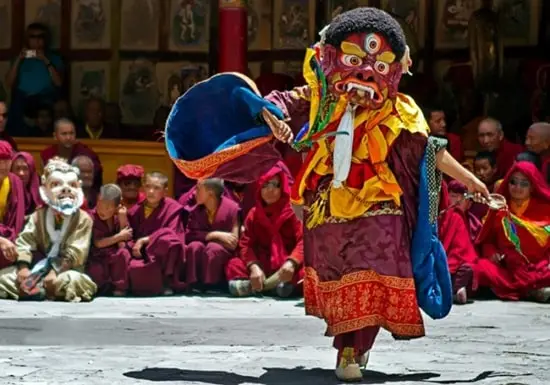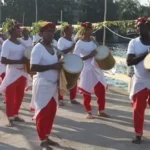Ladakh, located on the Northeast India, is an absolute conglomeration of beauty and culture. The “Little Tibet”, has awe-striking mountains and breathtaking visual beauty and at the middle of this endless beauty, the art of dancing happens to be one of Ladakh’s best attractions for art and culture lovers. Here we will be discussing about the traditional dance forms of Ladakh.
1. Chhams: The Sacred Dance Drama

The Chham, performed by Buddhist monks during religious festivals, is one of Ladakh’s most renowned dances. This Tibetan Buddhist cultural treasure goes beyond art. This is particularly true during Ladakh monastic festivals like the Gustor Festival. Chhams’ vivid colors, intricate costumes, stunning masks, and flawless movement are visually and spiritually captivating. Silk brocade-robed dancers in god masks reenact Buddhist legends. Harmonized gestures, rhythmic feet, and melancholy traditional instrument melodies provide a captivating presentation. This immersive play transports performers and audience to a mysterious world where earth and heaven merge. Its religious roots make the Chham a powerful medium for sacred narrative. Through cultural and spiritual expression, the dances connect Ladakh’s past to the present. Each Chham movement and gesture is profound, making it a sensory feast and a thorough exploration of the region’s spirituality. Chams, an integral part of Ladakh’s culture, show tradition’s resilience. Ladakh’s rich culture and spiritual dedication are reflected in these dance-dramas.
2. Jabro Dance: Celebrating Harvest and Prosperity
A good harvest is celebrated in Ladakh, where agriculture is tough. The Jabro Dance, or crop Dance, celebrates a bountiful crop and prays for prosperity. The native Jabro Dance energizes abundant festivities. Foot stomping and hand clapping liven up the dance. The circle flows nicely to drums and flutes. Lively group festivities promote unity and fun. The Jabro Dance’s vibrant outfit embodies Ladakhi culture. Traditional regional clothing is used by dancers. The vibrant colors and intricate designs make the dance joyful. The Jabro Dance is beautiful and reflects Ladakhi tenacity in agricultural issues. It fosters communal spirit, celebration, and achievement. The Jabro Dance’s colorful rhythms and dances convey Ladakh’s farmers’ connection to the soil and hope for the future.
3. Tukhchum: The Graceful Masked Dance
Ladakh’s tukhchum dance’s graceful motions and lavish costumes fascinate viewers. The secular Tukhchum represents Ladakhi culture during festivals and social occasions, unlike the sacred Chhams. Tukhchum is known for its elaborate Ladakhi animal, deity, and personality masks. The dancers’ masks add mystery and significance, creating a visual story of the region’s culture. The graceful dancers in Ladakh-themed costumes captivate the audience with every step. The dance’s culturally intertwined choreography preserves and transmits Ladakh’s oral traditions. As they go around the stage, Tukhchum dancers’ symbolic masks become their spirits. Animated movement and symbolism fascinate spectators and protect Ladakhi tradition. Tukhchum represents Ladakh’s culture. This exquisite dancing technique preserves Ladakh’s stories and traditions in its people’s hearts and minds.
4. Shondol: The Dance of Elegance
The Ladakhi shondol dance signifies joy and elegance, particularly during weddings. In an impressive spectacle, the bride and groom star alongside family and friends. This dance signifies the newlyweds’ joining of two families and a new phase. Performers in Ladakhi attire and fine jewelry and accessories display the region’s rich cultural past. Slow, deliberate dancing moves create tranquility and solemnity. Oboe and drum music enhances the ceremonial atmosphere and gives the gathering a classic character. Shondel signifies the community’s values and practices, not only wedding decorations. The dance’s choreography and music incorporate Ladakhi culture into the wedding. Not only a dance, shondol is visual poetry about marriage and communal values. As performers dance in unison and wear ancient regalia, shondol shows Ladakh’s cultural variety and the value of traditions in changing times.
5. Yuru Kabgyat: Integrating Rituals and Dance
Lamayuru Monastery’s Yuru Kabgyat festival combines religious rituals with traditional dances to produce a magnificent performance. This multicultural festival attracts residents and inquisitive guests. Yuru Kabgyat dances with lamas in elaborate costumes and masks are stunning. Lamas may successfully act out Buddhist scriptures using these beautiful masks. The dance becomes a live artwork, immersing participants and spectators in Buddhist stories. Yuru Kabgyat teaches Buddhism via art beyond its beauty. Dance performances reveal Buddhist scriptures’ fundamental truths, promoting spiritual insight. Ladakh’s diverse spirituality is reflected in its colorful dances and solemn religious procedures. Yuru Kabgyat represents Ladakh’s spiritual preservation and sharing. The festival fosters local creativity and spiritual-art connections. Lamas gracefully dance, honoring Ladakh’s traditional character and inviting everyone to experience this wonderful confluence.
Preservation and Evolution of Ladakhi Dances
Ladakh’s dances fluctuate despite their cultural and religious roots. Over time, many dances have added characteristics while retaining their foundation. Modernization, education, and cultural interactions keep Ladakhi dance styles current. The culture of Ladakh depends on preserving and promoting its ancient dances. Cultural, municipal, and government groups arrange festivals, seminars, and educational programs to preserve Ladakhi dances.
Conclusion
In brief it can be said that it will be wrong to assume that these traditional dances of Ladakh are only occasional performances. Each dance form offers a wonderful presence of the natural beauty of Ladakh. Be it the Chhams or the Jabro, each of the dance forms delineate endless stories, tales of the land. Through the body movements with the rhythms, endless beautiful moments are created in these dance forms, capturing the imagination of the beholders.
Santosh Kumar, the author behind IndiasStuffs.com, is passionate about sharing valuable insights on a variety of topics, including lifestyle, technology, and Indian culture.
Page Contents

